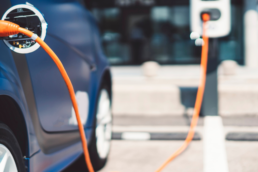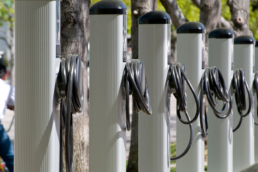Position paper on CO2 standards for cars and vans
Position paper on CO2
Standards for cars and vans
The Platform for Electromobility supports the overall greenhouse gas emissions reduction target of 55% by 2030 and the climate neutrality objective by 2050. Reducing – and ultimately eliminating – emissions from cars, vans and trucks will be key to achieving these objectives.
The Platform for Electromobility would like to emphasise that the EU CO2 standards regulation delivers genuine benefits for transport, setting clear signals to both car makers and consumers on the required pace for the transition to zero-emission mobility. This regulation is the most effective way to do so, when compared to the extension of the ETS system to road transport.
The future cars and vans CO2 legislation will increase the offer and promote the market uptake of zero-emission vehicles. With an increased market, zero-emissions vehicles will also become more affordable with a continuously reduced total cost of ownership and more choice for consumers and will also help tackle air quality and noise issues, bringing an overall benefit to society.

For Europe to become carbon neutral by 2050, road transport needs to be entirely decarbonised by this date. Considering the average retirement age of petrol and diesel vehicles in Europe (around 15 years), the Platform for Electromobility believes that an EU-wide phase-out date for sales of new pure internal combustion engine passenger cars and vans no later than 2035 is necessary to achieve this objective with a clear emissions reductions trajectory. After 2035 looking at the overall life cycle carbon footprint of vehicles could be a relevant factor to consider.
Setting binding annual CO2 targets would be optimal from a climate perspective and would ensure a continuous CO2 emissions reduction trajectory. Such targets should follow a long-term emission reduction trajectory to ensure sufficient visibility for industry (ensuring annual targets are set sufficiently in advance, and minimum of 5 years). The current design of the car and vans CO2 regulation targets – whereby targets kick-in in five years intervals with no emission reductions required in between – is suboptimal from a climate perspective and means CO2 emissions actually increase in between, as was seen between 2016 and 2019 from new car sales.
The revised regulation should set significantly higher targets for CO2 emissions from 2030 and adding a binding interim target in 2027 of at least 37,5% CO2 emissions reduction (a date consistent with the technology reset required by the Euro 7 emission standard) to secure a more linear CO2 emission target trajectory and ensure new vehicles can fairly contribute to the higher overall GHG reduction target for 2030.
In addition to the CO2 targets, a mechanism incentivising zero-and low-emissions vehicles (ZLEV) should be maintained in the period up to 2030. Only zero-emissions vehicles should be eligible for the incentive system, as well as vehicles with emissions below a threshold lower than 40 g CO2/km. Ultimately, the ZLEV benchmark/mandate level should be adapted from 2030 onwards, and only zero-emission vehicles should be eligible for any incentive system. The Platform for Electromobility considers that another incentive type could be envisaged – based on an accurate impact assessment and analysis – in the form of a bonus-malus for the period up to 2030 with a realistic threshold. After 2030, the bonus would be removed to be replaced by a unique malus.

In addition, regarding specificities of vans (professional purposes, goods & persons transport) it should be considered to differentiate between the target levels for cars and vans until 2035.
The Platform is opposed to any mechanism that would consider the contribution of renewable and low carbon fuels in the compliance assessment for each manufacturer. Policies focused on decarbonising fuels and those focused on reducing emissions from cars and vans must remain in separate legal instruments.
We would like to underline that new skills and qualifications for workers in the automotive value chain will be needed. Excess emission premiums, which are paid by OEMs whose average specific emissions of CO2 exceeded their specific targets and whose amounts are considered as a revenue for the general budget of the EU, should be allocated to a new or existing fund or relevant programme with the objective of ensuring a just transition towards a climate-neutral economy, in particular to support re-skilling, up-skilling and other skills training and reallocation of workers in the automotive sector and ecosystem.
Data collected from fuel consumption meters (FCMs) – fitted as standard on all new cars from 2021 onwards – should be used for consumer information and vehicle labelling purposes, either via a review of the car labelling directive, or via direct amendments to the cars CO2 regulation, and from 2025 onwards be used for compliance with CO2 targets.
The Platform supports removing the target mass adjustment mechanism. Removing the target mass-adjustment mechanism has many benefits: it removes a structural weakening of the regulation; ensures that all carmakers have the same target therefore pushing the larger and more polluting segments to electrify more rapidly, in line with their heavier climate impact; and it simplifies the regulation.

The decarbonisation of the transport sector needs a holistic approach. The planned revision of the Alternative Fuels Infrastructure Directive (AFID) needs to support the harmonised roll-out of a high-quality charging infrastructure for BEVs. It should be turned into a regulation for road transport infrastructure and set minimum mandatory targets per Member States for the deployment of publicly accessible charging points with a minimum quality service requirement that are accessible for every consumer.
The Platform for Electromobility urges the Commission to seize the unique opportunity of the Fit for 55 package and of the Green Recovery Fund to achieve the EU Green Deal’s goal to fully decarbonise road transport by 2050 and make electromobility a lifelong reality.
Input to Smart and Sustainable Mobility Strategy
Electromobility is the best solution to achieve the climate and industrial ambition of the European Green Deal for transport. The Sustainable and Smart Mobility Strategy will present the European Commission’s new vision on mobility for the upcoming years and must thus set a long-term and ambitious policy framework and support the further electrification of all modes of transport. It needs particularly to support the roll-out of an accessible charging infrastructure network for all modes of transport. The urgent revision of the TEN-T guidelines and AFI Directive for road and rail must occur without any delay and will ensure the decarbonisation of both modes of transports. The revision of the AFI Directive must be ambitious and should clearly set minimum binding targets per the Member States and type of vehicles (LDVs and HDVs) for the deployment of charging infrastructure for low- and zero emission transport technologies in order to reach the 2050 climate neutrality objective.
Smart charging, and demand-side resources (i.e. vehicle to grid) will therefore constitute a key enabler to strengthen future synergies between transport, digital, and energy sectors, supporting Europe’s energy transition and fostering technological innovation. In line with the Energy System Integration Strategy, the Platform for Electro-Mobility recommends that EU and Member States’ policy-makers encourage and develop policies in support of these innovative system integration technologies to unlock all the benefits it can deliver to the electricity system and to society at large. The European Commission must also make sure that the synergies between energy and mobility are maximised with adequate financial cross-sectoral schemes. Funding and support for electrical upgrades (within buildings as well as grid connections) necessary to install charging equipment should also be made available to consumers, for instance through the upcoming Renovation Wave initiative, and namely through the revision of European Performance of Buildings Directive. Support for zero emission mobility will address the behavioural changes and answer the growing demand. Therefore, it would be important for the Commission to shape regulations to drive affordable supply of EV models and design mechanisms to enhance the consumers’ uptake of electro-mobility innovations and ensure social inclusion of lower income households. The corporate market is a clear lead market for electrification and the strategy should include mechanisms to require more and more fleets such as company cars, taxis and delivery vehicles to electrify and support companies towards this goal. It is also key to rebalance the modal shares with a view to encouraging a greater use of energy-efficient modes with the highest electrification rates such as rail as well as measures to ensure the modal shift to rail.
The Battery Directive will be key to create a sustainable environment and should provide conditions for the EU to become more competitive. The new strategy should also support innovative and competitive business models for the second life and recycling of EV batteries. The Smart and Sustainable Mobility Strategy should recognise the vital role of businesses in stimulating the EV market and providing EV charging to help make e-mobility a more affordable and viable option for citizens across the EU.
New mobility zero emission shared services alongside public transport (bus, rail, tram and metros) have a key part to play in the electrification of urban transport. In cities, the development of a sustainable and efficient urban freight, with a focus on zero emissions trucks as well as last-mile delivery services, are long-term solutions which need to be stimulated. Furthermore, taxation is a central driver for the decarbonisation of transport, and it is essential that the EU’s taxation rules are aligned with its decarbonisation commitment. Specifically, the revision of the Eurovignette and the Energy Taxation Directivesis a chance to build a future-proof taxation policy, adapting to a modern and decarbonised economy while accompanying the uptake of electromobility by integrating a CO2 component.
The Platform for Electro-mobility unites organisations from across civil society, industries, cities and transport modes. Its members are committed to promote electro-mobility and strive to collectively develop solutions to electrify European transport, and to promote those solutions to the EU institutions and Member States. The Platform is working to create a sustainable, multimodal transport system in which people and goods are predominantly moved across land in Europe using sustainable electricity. The aim of the Platform is to drive the development and implementation of sustainable European Union policies, programmes and initiatives to move people and goods by electricity https://www.platformelectromobility.eu.
On 11 December 2019, the European Commission unveiled the EU strategy on climate neutral Europe, or the European Green Deal. The strategy promises to ensure that there are no net greenhouse gas (GHG) emissions by 2050, including increasing the EU’s 2030 GHG reduction target to at least 50%, and towards 55% in a responsible way. This clear shift towards sustainable and zero emissions technologies and economy-wide change is urgently needed if the EU is to meet the ambition of the Paris Agreement. Electro-mobility is already ubiquitous in our lives, from road vehicles to rail, as it is key to clean cities, affordable mobility of all Europeans and our industrial competitiveness.
In March 2020 the COVID-19 pandemic swept across Europe and confined Europeans to their homes, halting business activity and closing factories for months. As Europe slowly goes back to life, the deepest economic recession since the 1930s heralds a new normal. But the relevance of the Green Deal or the urgency of climate action have not disappeared – the twin challenges of economic and climate crises must be tackled together. Electrification is the strong basis to relaunch the economy and create futureproof jobs fast.
The Green Deal should be the basis of the economic recovery, starting with today. This policy paper outlines the Green Deal vision and green recovery recommendations of the European
Platform for Electro-mobility, representing almost 40 companies, associations and civil society across the electro-mobility ecosystem.
Notably:
- Electromobility remains the best solution to achieve the climate and industrial ambition of the European Green Deal for transport. This ecosystem is crucial to Europe’s economic
relaunch in the aftermath of COVID-19 and will create over 1 million jobs in vehicle and rail manufacturing, charging infrastructure deployment and supply chains such as batteries by
2030. - The EU Recovery Package must support the e-mobility ecosystem, including the continued demand for zero emission vehicles, green investments into e-mobility supply chains and
stimulus to accelerate the roll-out of charging infrastructure across Europe, notably workplace & residential schemes. - The Commission should not delay the enabling policies key to e-mobility’s success, including the urgently needed review of the Alternative Fuels Infrastructure law, the Sustainable Battery
package and the revision of the Energy Taxation Directive.
3rd June 2020
